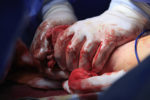Amputated limbs are something that you do not come across very often, especially in day-to-day life. It is most common in machinery accidents and in traumatic car crashes. However it is something that you may come across, so you should know how we deal with amputated body parts. The first thing to understand is that when dealing with amputated limbs, the priority is always going to be stemming the blood flow. Start by carrying out your primary survey which should be done quickly. In this, you are looking for life-threatening problems such as arterial bleeds which must be controlled immediately.
Each human has around five to six litres of blood in your body, which will leave very quickly from an arterial bleed. Of course, alert the Emergency Services as soon as possible, as they will need to send an ambulance – or maybe even a helicopter – as soon as possible.
Stemming the Blood Flow
All of the same principles apply here as they would for any other bleed. Blood finds it difficult to run upwards, so start by elevating the affected limb or body part. Then put pressure over the wound site. Again, once you apply pressure, the bleeding will start to slow. If there is a lot of bleeding, you might need to use trauma dressings. These are much larger, much thicker, and are able to soak up a lot more blood than multiple normal-sized dressing. If you are properly trained, you may be able to apply a tourniquet, however, this should only be done after special training. Since this is an arterial bleed, a tourniquet may be required sooner.
The Amputated Limb or Body Part
The body part which has been amputated could range from the tip of the finger to the entire arm or leg. Modern technology has meant that amputated body parts may be salvageable. It may be able to be restitched, the nerves reattached, and be workable again after some rehabilitation. As a First Aider, you have to deal with it correctly to allow that to happen.
The first thing to do after controlling the bleeding is to take the amputated body part and wrap it in cling film. Like when dealing with burns, ordinary cling film that you would use every day in the kitchen works perfectly for this. This forms a barrier of infection, keeping it clean and all in one area. Once you have wrapped it in cling film, then wrap that in either towels or thin blankets. This gives extra protection to the limb. After that, place the body part in iced water or even ice itself. This cools the limb down and impedes the cell deterioration process, making the limb salvageable for longer. NEVER apply anything cold such as ice directly to the stump, where it has been amputated from or the actual limb itself. This would cause cold burns, and this formulates a whole new problem. If you put ice directly on the wound ends, what you do is kill the nerves, actually making the body part entirely unsalvageable.
Transport
Both the patient and the limb must then be transported to the appropriate hospital as quickly as possible. Sometimes this is done by helicopter, as the patient might need to go to a specialist unit to have the correct surgery. So again, make sure that the correct back up is on its way.
Teeth
 A common type of amputation is knocking out one or more teeth. This happens to children in particular, as their milk teeth are weaker than their adult teeth. When adult teeth start to grow and you lose that tooth, no more will grow behind that. Like limbs, teeth can be reset; as long as we follow a few rules. The most important one is that as long as the root has come out with the tooth (the tooth has not just snapped), we can actually reset that root. To do this, it needs to be kept in milk. You should put the tooth and root into a cup of milk and take the patient to the nearest dentist. Once you arrive, hopefully the dentist will be able to reset it into the jaw, allowing it to regrow. Of course, the sooner you can get the patient to the dentist the better.
A common type of amputation is knocking out one or more teeth. This happens to children in particular, as their milk teeth are weaker than their adult teeth. When adult teeth start to grow and you lose that tooth, no more will grow behind that. Like limbs, teeth can be reset; as long as we follow a few rules. The most important one is that as long as the root has come out with the tooth (the tooth has not just snapped), we can actually reset that root. To do this, it needs to be kept in milk. You should put the tooth and root into a cup of milk and take the patient to the nearest dentist. Once you arrive, hopefully the dentist will be able to reset it into the jaw, allowing it to regrow. Of course, the sooner you can get the patient to the dentist the better.
For more information on training courses, visit our “Courses” page which also includes our First Responder and First Person on Scene (FPOS) Courses.


Pingback: Joint examination is the basic examination of any joint.
Pingback: Do you need an ambulance or is there a better option